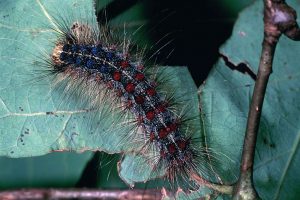Gypsy moth is a destructive pest. It prefers to feed on the leaves of oak, birch, apple, willow, sweetgum, linden, and hawthorn trees. The caterpillars may attack beech, pine, hemlock, crabapple, cherry, walnut, and hickory trees. These insects have become a periodic problem in US, Europe, and Asian countries, causing defoliating of huge forest land. The best way to get rid of this menace is to hire a professional pest control company instead of trying to do it

Gypsy bug/moth caterpillar
yourself. However, if the infestation is not so severe, here are some gypsy moth control methods that you may try:
- Destroying the egg masses is perhaps the best way to control the infestation.
However, it is the most difficult task too. You will have to physically look for the cream or buff colored masses and destroy them. They could be sticking to limbs, trunks, and wounded parts of the trees, corners of your windows and doors, fences, gutters, wood piles, and other outdoor surfaces. To destroy them, you need to scrap these egg masses out and collect them in a container. Fill the container with 50% soybean oil and 50% water and leave it for a day or two. The oil will suffocate the eggs and kill them. Do not leave the scrapped masses on the ground, as they will still be alive. This process can help control the population of gypsy moths but it is risky, as well as time-consuming. You will have to climb the trees to discover masses that could be hiding almost anywhere.
- If the eggs are already hatched, you can try the sticky barrier bands.
These bands are coated with sticky substances. You need to wrap them around the trunk of the tree. When the caterpillars try to climb up or down the tree, they will stick to the barrier band. You can collect them in a jar filled with soapy water and keep them within the jar until they die. Make sure you wrap the band tightly, leaving no space for the caterpillars to escape. The band should be pliable enough to fit into cracks and crevices or else gypsy moth larvae will find their way to escape. Sticky barrier bands should be readily available in your nearby gardening store.
- If you are looking for a completely chemical-free and hassle-free gypsy moth control method, try using burlaps.
The caterpillars are always looking for secret places to hide from predators. Burlap band, when wrapped around the tree trunks like an apron, can become their favorite hideout. To make a burlap band, wrap a strip of 12-14 inch wide burlap around the trunk of the tree and tie it at the center using a string or a wire. Fold the upper portion of burlap over the string to make it look like an apron. The ideal height of placing the burlap band is about 5’ from the ground. While moving up and down, the caterpillars will start taking shelter in the band. All you need to do is to collect them in a jar of soapy water and keep them there until they die. This method is quite effective for light to moderate infestation and should be done throughout May and June.
- Birds, white-footed mice, and ground beetles love to snack on gypsy moth caterpillar.

Male Gypsy Moth photo by Leslie J. Mehrhoff, University of Connecticut, Bugwood.
You can introduce them in your garden or agriculture land but their effectiveness is doubtful, especially if the infestation is too high. This insect’s ability to reproduce itself is so high that natural predators can hardly make any significant difference.
- Synthetic pheromone (i.e. sex hormone) should be available in your local gardening stores.
These pheromones are traps; they attract male moths and trap them inside. When males are eradicated, the females won’t be able to reproduce and their number will decrease. This sounds great but pheromone traps are also not very effective in heavily infested areas. However, you may try them if there is a mild to medium infestation.
The conventional, organic gypsy moth control methods do not work in cases of severe infestations. The only way to stop large-scale defoliation and save your trees is to get a chemical treatment done by professional pest control companies. They will evaluate the level of infestation and will accordingly decide what form of treatment is necessary.

No Comments